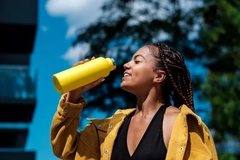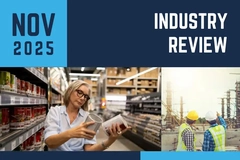
- Industry news
Industry news
- Category news
- Reports
- Key trends
- Multimedia
Multimedia
- Journal
- Events
- Suppliers
Suppliers
- Home
- Industry news
Industry news
- Category news
- Reports
- Key trends
- Multimedia
Multimedia
- Events
- Suppliers
Suppliers
UBQ Materials CEO: Giving household waste a new life as thermoplastic
UBQ Materials’ proprietary fusion process converts unsorted household waste, including organics and unrecyclable packaging waste, into thermoplastics that can be used in a wide range of applications.
Packaging Insights speaks to Albert Douer, CEO at UBQ Materials, about the company’s approach to addressing plastic pollution and waste management through material innovation.
Douer tells us more about how UBQ’s thermoplastic compares to other plastic alternatives and the waste to material transformation process. He further explores how the company supports its clients with EU regulatory compliance and circularity goals.
What differentiates UBQ from other plastic alternatives or recycled materials?
UBQ Materials turns mixed household waste into a thermoplastic composite.Douer: Today, waste is one of our biggest problems, and plastic is one of our biggest pollutants. UBQ is different from other plastic alternatives because it’s a transformative material that finds a novel solution to the problem.
At UBQ Materials, we give everyday household waste, including all the organics — chicken bones, banana peels, dirty diapers — a new life, without additional costs. UBQ is a climate-positive material that can be used in various durable and semi-durable applications across logistics and supply chains, building and construction, retail, auto, and more. Different from recycled materials, UBQ is homogeneous and can be supplied with guaranteed specifications every time.
UBQ Masterbatch, the latest product portfolio launched in late May 2025, offers retailers and manufacturers a price-stable, risk-resilient plastic alternative that integrates seamlessly into existing production lines.
However, perhaps one of the most important differentiators is that UBQ can be cost-competitive with all virgin oil-based plastics, regardless of the oil price. UBQ does not require the so-called “greenium” we have come to expect from sustainable products. This makes it a true alternative to traditional materials.
Can you walk us through the UBQ conversion process?
Douer: UBQ Materials’ patented technology takes mixed household waste, including organics and hard-to-recycle materials, and converts this feedstock into a thermoplastic composite. First, the waste is sorted to remove any metal, mineral, or glass present, and then those materials are sent to be properly recycled.
The remaining organic waste, like banana peels and chicken bones, is used in its entirety. The organics are broken into their most basic building blocks, including fibers, cellulose, lignin, collagens, and sugars. Inorganic materials are then bound to this matrix, reconstructing them into a new bio-based thermoplastic composite, UBQ. The resulting material is a single, patented homogenous composite that can be replicated time and time again and widely applied to manufacturing.
.jpg) Products made with UBQ look the same as products created with traditional plastics.All of this happens in our high-efficiency processing facility in the Netherlands. The production of UBQ prevents harmful greenhouse gas emissions, avoids pollution, reduces society’s reliance on conventional plastics, and minimizes the extraction of natural resources. In fact, the Netherlands facility runs entirely on renewable solar and wind power, uses zero water for the production process, and emits no harmful runoff.
Products made with UBQ look the same as products created with traditional plastics.All of this happens in our high-efficiency processing facility in the Netherlands. The production of UBQ prevents harmful greenhouse gas emissions, avoids pollution, reduces society’s reliance on conventional plastics, and minimizes the extraction of natural resources. In fact, the Netherlands facility runs entirely on renewable solar and wind power, uses zero water for the production process, and emits no harmful runoff.
Can you tell us more about your experience providing packaging materials for F&B giants like PepsiCo and McDonald’s?
Douer: UBQ is not certified food-contact safe, nor do we claim it to be. We work with our partners to incorporate the benefits of UBQ to F&B logistics and supply chains in a way that is safe for human and environmental health.
When we worked with PepsiCo, we focused on aligning with their strategic transformation, PepsiCo Positive, to put sustainability at the heart of the business. We created a sustainable pallet that was made with UBQ and incorporated across PepsiCo supply chains in Latin America.
With Arcos Dorados, the world’s largest independent McDonald’s franchisee, we went beyond packaging. We first made serving trays that met food safety standards by separating food with a paper barrier. The success of this project allowed us to expand to bench seating and electrical system components. The beauty of UBQ (and what it’s named after) is that it’s ubiquitous — there are so many ways it can be used.
Our work with large corporate brands demonstrates how incorporating UBQ, a carbon-negative material, into their value chains can support progress toward their Scope 3 emissions commitments.
Which industries are showing fast UBQ adoption, and where do you see the greatest potential for growth?
Douer: UBQ can be widely applied to a range of everyday goods, from flowerpots to outdoor furniture to building materials, and auto and beyond. The durability and versatility of UBQ allows us to engage with many industries for many products — from interior automobile trims with Mercedes Benz to clothes hangers to flowerpots with Crescent Garden, and even POP and signage materials with Palram. UBQ Materials’ future is limitless and we’re keen to engage with everyone.
How do you balance aesthetics, durability, and customer perception when replacing conventional plastics?
 By renewing household waste UBQ can help EU businesses align with the emerging regulations, says Douer.Douer: I am deeply familiar with conventional plastics, so when developing UBQ, we ensured our product could integrate itself into that space seamlessly. UBQ is durable and can be recycled at least 10 times without losing its properties, unlike most conventional plastics, which are usually downgraded each time they are recycled. Products made entirely or partially with UBQ look the same as products made with traditional plastics, so design is something we can explore with each of our partners.
By renewing household waste UBQ can help EU businesses align with the emerging regulations, says Douer.Douer: I am deeply familiar with conventional plastics, so when developing UBQ, we ensured our product could integrate itself into that space seamlessly. UBQ is durable and can be recycled at least 10 times without losing its properties, unlike most conventional plastics, which are usually downgraded each time they are recycled. Products made entirely or partially with UBQ look the same as products made with traditional plastics, so design is something we can explore with each of our partners.
We also ensure that products made with UBQ are clearly marketed to customers as something that is sustainable, so they can feel good knowing they’ve bought a product that is good for their home and great for the planet without compromising on any of the qualities that draw them to plastic in the first place.
How aligned is UBQ with the EU’s circular economy and packaging regulations?
Douer: At the core of UBQ is the circular economy. By renewing household waste, UBQ helps businesses all over the EU step away from the linear economy model, bend that line, and go circular. UBQ Materials is strongly aligned with the EU’s current and emerging circular economy and packaging regulations, particularly the Packaging and Packaging Waste Regulation (PPWR) and the broader Circular Economy Action Plan (CEAP), both of which are core pillars of the European Green Deal.
UBQ Materials’ production process supports the PPWR’s goals of minimizing packaging waste and making all packaging recyclable by 2030 and aligns with CEAP priorities by keeping materials in use, lowering emissions, and enabling circularity in high-impact sectors like packaging and construction. UBQ Materials turns what would be packaging waste into materials that can live a whole new life at home, in stores, and across supply chains.












